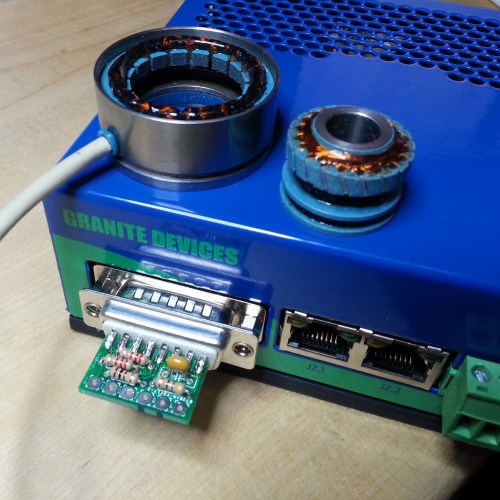Resolver a.k.a. synchro is a position sensor born long time before encoders. They are fully passive components consisting only coils and iron which makes them very robust in harsh conditions – including hot running servo motor under vibration, dust and dirt.
Despite being largely replaced by encoders, resolvers are still surprisingly popular even in new motors. Infineon, one of the largest microcontroller companies, even introduced a new MCU with integrated RDC (resolver to digital converter).
Resolver should be interesting also for DIY people as eBay is full of perfectly fine servomotors equipped with resolvers for bargain prices.
Argon supports resolvers with help of a small adapter board that hooks directly to the feedback device connector. Testing of this adapter however has to wait until final drives are received as pin-out of the Argon feedback port was modified to be more soldering friendly and the adapter in the photo is already designed for the new pin-out.


hi Tero
what is the accuracy of this type of encoder ?
Can be used for the control of axis machine tools ?
ps: Have you news of the production of the first ARGON ?
Greetings
Precision depends of RDC specs and resolver quality. With Argon I expect to see about 12 bits resolution (abt 1/4000 of revolution), but there will be a post about that once I have chance to test it. Anyway they should be definitely suitable for machine tools.
No production date yet confirmed but PCB assembly shouldn’t take longer than ~1 month. I don’t have estimate of enclosures yet.
Hi!
The resolution and the precision of the resolver depends on the quality of the excitation signal (it’s nothing more than a rotating transformer). A resolution of up to 16 bit is possible, but it’s not the effective precision. Anyway 12 bit is an achievable precision especially using a good sigma/delta ADC.
The advance of this cheap and robust position sensor is that it’s a single turn absolute encoder – if it has only one pole pair, i.e. one period per revolution.
The inaccuracy comes mostly from the possible eccentricity between the rotor and stator which results in a nonlinearity inside the revolution. As well as because af precise synchronization of the sample time to the excitation frequency. is needed.
If a RDC is used, you can calculate with a precision of the positioning loop about 11-12 bit, which is enough for the most of the machining tools using screw drives.
A better explanation could be found here http://www.optoresolver.com/help/tutorials/resolver_v_encoder.htm
Not sure if excitation signal plays that large role. At least resolver output seems to follow input waveform shape regardless whether input is sinusoidal or square. More important factors are the synchronized sampling point and software compensations of mismatching amplitude of secondaries.
Meanwhile, I got lead time for enclosures: 5 weeks. That may be quite accurate estimation of availability of the first drives!
I have checked your website and i have found some duplicate content, that’s why
you don’t rank high in google’s search results, but there is
a tool that can help you to create 100% unique articles,
search for: Boorfe’s tips unlimited content